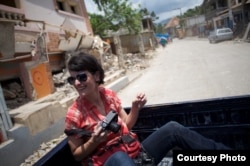Scout Tufankjian grew up with an unusual name and an unusual heritage.
Tufankjian -- whose first name is an homage to the young heroine of To Kill A Mockingbird -- was raised in Massachusetts by an Irish mother and an Armenian father.
Despite being raised in a multicultural home, she says she was always fascinated by her Armenian side. She would pore over her grandparents' Armenian newspapers, fascinated by the photographs of fellow Armenians living all over the globe.
"When I was growing up, there was this very small box that you had to fit into to be a good Armenian," says Tufankjian. "You had to have two Armenian parents and speak the language and go to Armenian schools and Armenian church."
These days, she says, "that box is really expanding."
Now a professional photojournalist, Tufankjian has spent the past six years pursuing her childhood obsession, traveling to locations as varied as Brazil, India, Russia, and Syria to photograph members of the Armenian diaspora.
The resulting book, There Is Only The Earth, takes its title from a story by Armenian American author William Saroyan, who wrote that the Armenian nation could not be defined by borders or territories.
"It really spoke to me," says Tufankjian, who covered the conflict in the Gaza Strip and earned fame for her campaign pictures of U.S. President Barack Obama, including the "most-liked" photograph in Internet history.
"What this project is about is identity that goes beyond these man-made geographical borders, and the idea that it's the humanity that people have in common, and not these border lines."
Tufankjian's book comes as the world prepares to mark the 100th anniversary of the start of the mass slaughter of hundreds of thousands of Armenians by Ottoman-era Turks in World War I.
Some 8 million Armenians are now estimated to be living in 85 countries across the world, the descendants of those forced to leave their ancestral home in Anatolia in modern-day Turkey .
Tufankjian photographed everyone from altar boys in Ethiopia and young socialites in California to migrant workers in Moscow and villagers in Lebanon whose traditions remain strongly rooted in the past.
But as diverse as her subjects were, Tufankjian says there is an "invisible thread" that invariably holds all Armenians close.
"Some of it is the food, some of it is the family," she says. "There's the traditional music. Everyone to some extent has kept some aspect of the old country within them. We all have a shared sense of what our past is. And I think that is one of the things that ties us all together."
Using crowdsourcing and diaspora grants to finance her travels, Tufankjian eventually traveled to more than 20 countries with significant Armenian populations.
While her photographs from the United States show cheerful Girl Scouts and LGBT activists, some of her most moving images are from prewar Syria, where large, vibrant Armenian communities thrived in cities like Aleppo and Damascus.
Now, many of Syria's Armenians have moved on once again -- as refugees to Lebanon, the post-Soviet Republic of Armenia, and Nagorno-Karabakh, the disputed and predominantly Armenian separatist territory located within Azerbaijan. Those Armenians are featured in Tufankjian's book as well.
The "gaping hole" in her project, she says regretfully, is Iran -- home to an estimated 80,000 ethnic Armenians.
"Iran has a huge, important community, and I was unable to get a visa," says Tufankjian. "I don't know if it's because of my background photographing Obama or if the timing was just wrong, but anyway, I couldn't get a visa, so I couldn't go."
Tufankjian says she initially doubted her right to pursue such a project, wondering if a half-Armenian who spoke only perfunctory Armenian could ever fit in among "real" Armenians.
What she found by the end was that her feeling was hardly unique. "A lot of Armenians wrestle with the question of whether they're the 'right kind,'" she says. "But as I say, that box is getting bigger."
She ended her photography project in the Lebanese village of Anjar, the home of Musalehr Armenians -- including Tufankjian's great-grandparents -- who had the rare distinction of fighting off their Turkish attackers in 1915.
A local priest recognized her last name and welcomed her as a "daughter of Musalehr." She photographed the late-night dancing and music that accompanied the September celebrations of Surp Khach, or Holy Cross Day.
"They make traditional food all night and they play traditional instruments, the dhol and zurna, which is very primal, this music. I'm a real sucker for it, personally," she says. "It was incredibly meaningful for me."
Tufankjian says she plans to spend April 24 in Istanbul, where a number of Armenian civic organizations are planning a special commemoration. "My family is from what some people call Western Armenia, what is now considered Turkey," she says. "It's important for me to be there."
At the same time, Tufankjian says it's important not to limit global perception of Armenian history to the massacre, an event that many -- including, most recently, Pope Francis -- commonly refer to as the Armenian Genocide.
"It's the defining trauma that colors our history and colors our lives," says Tufankjian. "At the same time, we are so much more than the genocide."
What she's hoping, she says, is that the 100-year commemoration will mark not only a century of loss, but also a century of survival.
"Because we have survived, and we have thrived," says Tufankjian. "And to look at us only as victims is to do us a disservice."
